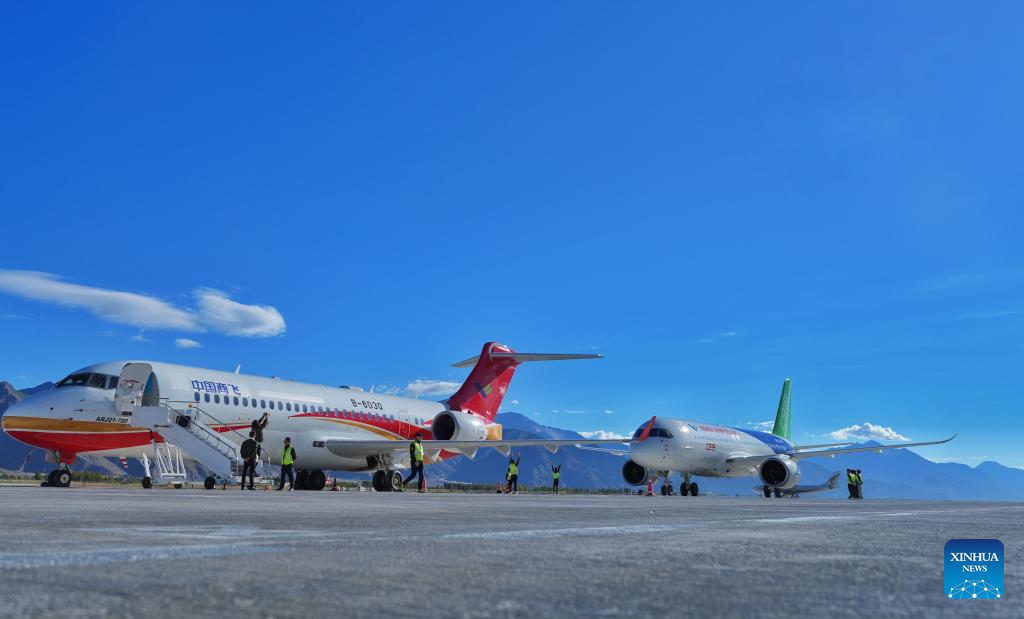
 0 Comment(s)
0 Comment(s) Print
Print E-mail China Daily, September 20, 2024
E-mail China Daily, September 20, 2024

A C919 passenger aircraft (R) is parked next to an ARJ21 aircraft at Lhasa Gonggar International Airport in Lhasa, southwest China's Xizang Autonomous Region, Sept. 19, 2024. [Photo/Xinhua]
China's domestically developed single-aisle aircraft, the C919, landed at Lhasa, Xizang autonomous region for the first time on Thursday, as the model verifies its adaptability to ultra high-altitude airports and routes.
The C919 jet, operated by its developer Commercial Aircraft Corp of China, or COMAC, departed from Chengdu Shuangliu International Airport (CTU) on Thursday morning and arrived at Lhasa Gonggar International Airport (LXA) after about two hours of flight.
Located in the Yarlung Zangbo River valley at an altitude of 3,569 meters, the Lhasa airport is surrounded by mountains. The meteorological environment is complex and poses a number of aeronautical challenges for aircraft and crew.
As such, the C919 plane will carry out research and development test flights of key systems for high-altitude operations, including environmental-control system, avionics and power units, as the company prepares the plane to meet the operational needs of ultra high-altitude routes and the R&D of the plateau variant in the future, COMAC said.
So far, the C919, comparable with the narrow-body Airbus A320 and Boeing 737 series, has netted more than 1,000 orders from home and abroad.
Earlier this year, Tibet Airlines, a regional carrier based in Lhasa, signed a deal with COMAC for 40 C919 aircraft of the plateau variant which is designed to meet the complex transportation requirements of high-altitude regions by shortening the fuselage and featuring high-altitude modifications.
"China has the world's largest demand for high-altitude aircraft operations," said Lin Zhijie, a civil aviation industry analyst. "The plateau variant of the C919 is of great significance for meeting the travel demand of passengers in high-altitude regions of China."
Meanwhile, China's first home developed regional passenger jet, the ARJ21, is close to finishing its month-long ultra high-altitude demonstration flights around the Qinghai-Xizang Plateau that will fully assess the adaptability of the model for ultra high-altitude airports and routes. The C919 and the ARJ21 gathered in Lhasa on Thursday.
Since Aug 21, the ARJ21 aircraft started its demonstration flights around the plateau, using Chengdu, Sichuan province; Xining, Qinghai province; and Lhasa as operational bases. So far, the ARJ21 plane has completed flight tests on 25 routes for a combined total of 62 flight hours, covering 11 ultra high-altitude airports in China.
In particular, the jet has flown to the world's highest civil airport four times, and fully verified its adaptability to ultra high-altitude operations. Located 4,411 meters above sea level, Daocheng Yading Airport (DCY) in Sichuan province is not only the highest civil airport in China, but also the world.
Airports located at an altitude of 2,438 meters or above are regarded as ultra high-altitude airports, and China has 25 such airports, accounting for more than half of such airports globally with a runway length of over 2,000 meters each, according to the Civil Aviation Administration of China.
High-altitude regions face conditions such as sparse oxygen supply, complex terrain and ever-changing weather conditions. The requirements for aircraft performance, crew qualifications and operational support capabilities are extremely high, the CAAC said.
Go to Forum >>0 Comment(s)